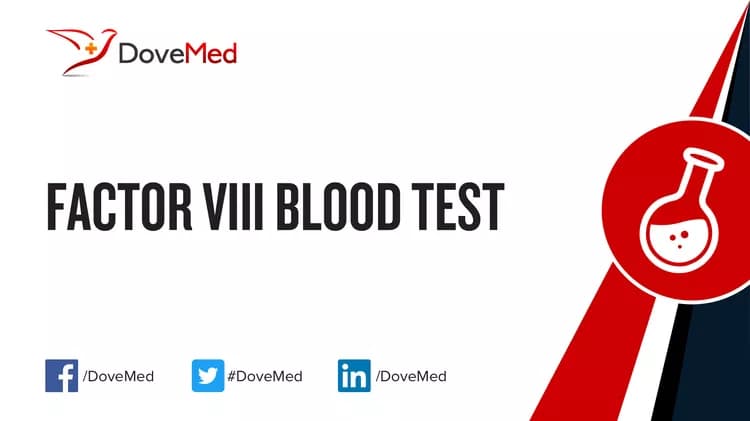What are other Names for this Test? (Equivalent Terms)
- Factor VIII Blood Level Test
What is Factor VIII Blood Test? (Background Information)
- Factor VIII is one of 12 clotting factors (though they are labeled I-XIII, factors V and VI are actually the same). Clotting factors are proteins that help form blood clots at the site of blood vessel injury. A blood clot stop blood loss and allows the blood vessel to continue functioning.
- The clotting process starts with injury to a blood vessel, which causes it to constrict. Called the vascular phase, this is the first reaction of a blood vessel to damage. Constriction of a blood vessel reduces the flow of blood to the site of injury, which minimizes blood loss.
- Next, circulating platelets clump along the site of blood vessel injury. Platelets form a foundation for a blood clot and release chemicals that stimulate clotting.
- The coagulation phase then causes a blood clot to form. Clotting occurs when an enzyme called thrombin converts a soluble protein, fibrinogen, into its insoluble form, fibrin. Fibrin proteins make up the bulk of a blood clot.
- Thrombin is activated by the merging of two pathways, called the intrinsic and extrinsic pathways, into the common pathway. These are initiated by different parts of the body after blood vessel damage:
- The intrinsic pathway begins in the blood with the activation of circulating proteins.
- The extrinsic pathway begins in the blood vessel with the release of protein factors by damaged cells lining the vessel.
- The extrinsic pathway is the first to activate. The intrinsic pathway then reinforces the extrinsic pathway and provides longer-lasting clotting effects.
- Coagulation factors such as factor VIII are central to the action of these pathways. Each factor activates the next in a stepwise fashion.
- Factor VIII is active in the common pathway. It helps reinforce the blood clot. Factor VIII is made in the liver.
- Once a coagulation factor is activated, it remains active. Thus, with each step in the pathway, more and more factors are activated. This results in a cascade of events similar to the snowball effect.
- A counter pathway ensures that the size of the growing blood clot stays in check. Problems with this regulatory pathway may lead to a dangerous condition where a blood clot forms within blood vessels (thrombosis).
- The Factor VIII Blood Test determines levels of factor VIII in the blood by assessing its function. It aids in the diagnosis of bleeding disorders, especially those that are genetic, due to factor VIII deficiency.
What are the Clinical Indications for performing the Factor VIII Blood Test?
Clinical indications for performing the Factor VIII Blood Test include:
- Following up to a prothrombin time (PT) or partial thromboplastin time (PTT) blood tests
- Excessive bleeding
- Family history of coagulation factor disorders
How is the Specimen Collected for Factor VIII Blood Test?
- Sample required: Blood
- Process of obtaining a blood sample in adults:
- A band is wrapped around the arm, 3-4 inches above the collection site (superficial vein that lies within the elbow pit).
- The site is cleaned with 70% alcohol in an outward spiral, away from the zone of needle insertion.
- The needle cap is removed and is held in line with the vein, pulling the skintight.
- With a small and quick thrust, the vein is penetrated using the needle.
- The required amount of blood sample is collected by pulling the plunger of the syringe out slowly.
- The wrap band is removed, gauze is placed on the collection site, and the needle is removed.
- The blood is immediately transferred into the blood container, which has the appropriate preservative/clot activator/anti-coagulant.
- The syringe and the needle are disposed into the appropriate “sharp container” for safe and hygienic disposal.
- Preparation required: No special preparation is needed prior to the Factor VIII Blood Test.
What is the Significance of the Factor VIII Blood Test Result?
A low value (less than 70%) for the Factor VIII Blood Test may mean:
- Disseminated intravascular coagulation (DIC)
- Liver disease
- Congenital deficiency
A high value (greater than 150%) for the Factor VIII Blood Test may mean increased risk for venous thromboembolism.
The laboratory test results are NOT to be interpreted as results of a "stand-alone" test. The test results have to be interpreted after correlating with suitable clinical findings and additional supplemental tests/information. Your healthcare providers will explain the meaning of your tests results in the context of the overall clinical scenario.
Additional and Relevant Useful Information:
- Coagulation factors were named in the order of their discovery. For example, Factor I was the first factor discovered. Their names have nothing to do with the order in which they act during the clotting process.
- Factor VI was later proven to be a modified version of Factor V. Thus, the name Factor VI is no longer used.
Certain medications that you may be currently taking may influence the outcome of the test. Hence, it is important to inform your healthcare provider, the complete list of medications (including any herbal supplements) you are currently taking. This will help the healthcare provider interpret your test results more accurately and avoid unnecessary chances of a misdiagnosis.
The following DoveMed website links are useful resources for additional information:
http://www.dovemed.com/common-procedures/procedures-laboratory/coagulation-factors-blood-test/
http://www.dovemed.com/diseases-conditions/factor-ii-deficiency/
http://www.dovemed.com/diseases-conditions/factor-v-leiden-thrombophilia/
Related Articles
Test Your Knowledge
Asked by users
Related Centers
Related Specialties
Related Physicians
Related Procedures
Related Resources
Join DoveHubs
and connect with fellow professionals


0 Comments
Please log in to post a comment.